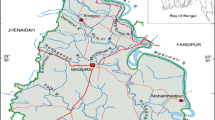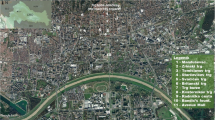Abstract
The element concentrations in potable water samples collected in two different urban areas for the water supply, Rome and Florence, are determined by INAA and compared. The results on drinking water of Rome show that the potentially toxic elements (Sb, Hg, Cr, Ni, etc.) are present at levels below the limit values whereas the essential human elements give a convenient nutritional support. Further, it is also evidenced that the elemental composition is quite similar to that of uncontaminated natural waters. According to the drinking water of Florence the characterization of the concentration of elements show an almost good situation except for Al.
Similar content being viewed by others
References
G. C. Cotsias, Trace Substances in Environmental Health, D. D. Hemphill (Ed.), University of Missouri, Columbia, 1967, p. 5.
E. Sabbioni, L. Goetz, C. Birattari, M. Bonari, Sci. Total Environ., 17 (1981) 257.
R. Friberg, G. F. Nordberg, V. B. Vouk, Handbook on the Toxicology of Metals, Elsevier Science Publisher B.V., Amsterdam, 1986, p. 14.
P. Blasi, G. Capannesi, A. Cecchi, F. Lucarelli, F. A. Sedda, Biol. Trace Element Res., 26 (1990) 363.
P. Avino, G. Capannesi, A. Rosada, Toxicol. Environ. Chem., 88 (2006) 633.
P. Avino, G. Capannesi, A. Rosada, Prev. Today, 3 (2007) 13.
Decreto Legge (D.L.) February 2 2001, n. 31. Accomplishment of the EC Instruction n. 98/83/EC, Related to Water for Human Uses.
World Health Organization, Guidelines for Drinking Water Quality, Vol. 2, Health Criteria and Other Supporting Information, WHO, Geneva, 1984.
M. G. Pellegrini, M. Cacchioni, R. Riccioni, F. Tarantini, Ig. Mod., 76 (1982) 483.
G. Tamasi, R. Cini, Sci. Total Environ., 327 (2004) 41.
B. Sansoni, W. Brunner, G. Wolff, H. Ruppert, R. Dittrich, Fresenius Z. Anal. Chem., 331 (1988) 154.
V. A. Pavlov, V. A. Petrukhin, V. G. Onufriev, V. V. Romanov, Water Res., 5 (1978) 840.
B. Salbu, E. Steinnes, A. C. Pappas, Anal. Chem., 47 (1975) 1011.
Author information
Authors and Affiliations
Corresponding author
Rights and permissions
About this article
Cite this article
Capannesi, G., Diaco, L., Rosada, A. et al. Investigation of trace and ultra-trace elements of nutritional and toxicological significance in Italian potable waters by INAA. J Radioanal Nucl Chem 278, 353–357 (2008). https://doi.org/10.1007/s10967-008-9609-x
Received:
Published:
Issue Date:
DOI: https://doi.org/10.1007/s10967-008-9609-x




